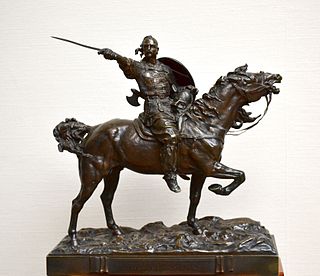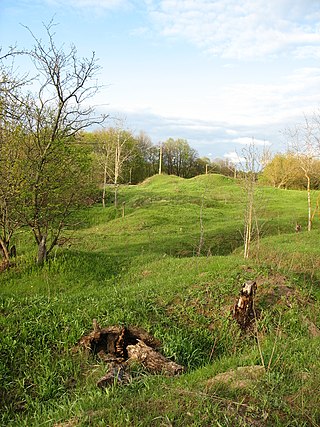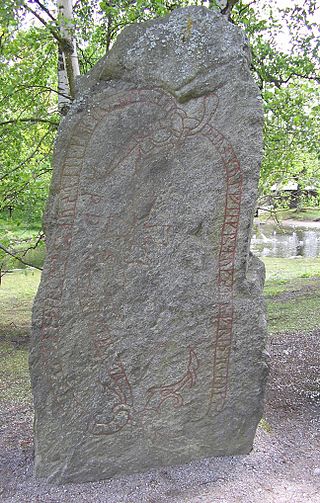
The Viking Age (793–1066 CE) was the period during the Middle Ages when Norsemen known as Vikings undertook large-scale raiding, colonising, conquest, and trading throughout Europe and reached North America. It followed the Migration Period and the Germanic Iron Age. The Viking Age applies not only to their homeland of Scandinavia but also to any place significantly settled by Scandinavians during the period. The Scandinavians of the Viking Age are often referred to as Vikings as well as Norsemen, although few of them were Vikings in the sense of being engaged in piracy.

Sviatoslav or Svyatoslav I Igorevich was Prince of Kiev from 945 until his death in 972. He is known for his persistent campaigns in the east and south, which precipitated the collapse of two great powers in Eastern Europe, Khazaria and the First Bulgarian Empire. He conquered numerous East Slavic tribes, defeated the Alans and attacked the Volga Bulgars, and at times was allied with the Pechenegs and Magyars (Hungarians).

Portage or portaging is the practice of carrying water craft or cargo over land, either around an obstacle in a river, or between two bodies of water. A path where items are regularly carried between bodies of water is also called a portage. The term comes from French, where porter means "to carry", as in "portable". In Canada, the term "carrying-place" was sometimes used.

The Dnieper, also called Dnipro or Dniapro, is one of the major transboundary rivers of Europe, rising in the Valdai Hills near Smolensk, Russia, before flowing through Belarus and Ukraine to the Black Sea. Approximately 2,200 km (1,400 mi) long, with a drainage basin of 504,000 square kilometres (195,000 sq mi), it is the longest river of Ukraine and Belarus and the fourth-longest river in Europe, after the Volga, Danube, and Ural rivers.

The Varangian Guard was an elite unit of the Byzantine Army from the tenth to the fourteenth century who served as personal bodyguards to the Byzantine emperors. The Varangian Guard was known for being primarily composed of recruits from northern Europe, including mainly Norsemen from Scandinavia but also Anglo-Saxons from England. The recruitment of distant foreigners from outside Byzantium to serve as the emperor's personal guard was pursued as a deliberate policy, as they lacked local political loyalties and could be counted upon to suppress revolts by disloyal Byzantine factions.

Berezan is an island in the Black Sea at the entrance of the Dnieper-Bug Estuary, Mykolaiv Raion, Mykolaiv Oblast, Ukraine. Located 8 kilometers from the city of Ochakiv and 4 kilometers from the resort village of Rybakivka. It is often being confused with the artificial island of Pervomaisky that is located within Dnieper-Bug Estuary. The Berezan island measures approximately 900 metres in length by 320 metres in width, the height of the northern part is 3-6 metres, the southern part is 21 metres. It is separated from the mainland by about a mile and a half of shallow water. Berezan is an integral part of the historical and archaeological reserve of the National Academy of Sciences of Ukraine "Olvia". The island is uninhabited. In the summer, archaeological expeditions of the IA NASU and the State Hermitage Museum work here. The archaeological site is regularly destroyed as a result of unauthorized excavations.

The Caspian expeditions of the Rus' were military raids undertaken by the Rus' between the late 9th century and c. 1041 on the Caspian Sea shores, of what are nowadays Iran, Dagestan, and Azerbaijan. Initially, the Rus' appeared in Serkland in the 9th century travelling as merchants along the Volga trade route, selling furs, honey, and slaves. The first small-scale Viking raids took place in the late 9th and early 10th century. The Rus' undertook the first large-scale expedition in 913; having arrived on 500 ships, they pillaged in the Gorgan region, in the territory of present-day Iran, and more to the west, in Gilan and Mazandaran, taking slaves and goods. On their return, the northern raiders were attacked and defeated by the Khazars in the Volga Delta, and those who escaped were killed by the local tribes in the middle Volga.

In the Middle Ages, the Volga trade route connected Northern Europe and Northwestern Russia with the Caspian Sea and the Sasanian Empire, via the Volga River. The Rus used this route to trade with Muslim countries on the southern shores of the Caspian Sea, sometimes penetrating as far as Baghdad. The powerful Volga Bulgars formed a seminomadic confederation and traded through the Volga river with Viking people of Rus' and Scandinavia and with the southern Byzantine Empire Furthermore, Volga Bulgaria, with its two cities Bulgar and Suvar east of what is today Moscow, traded with Russians and the fur-selling Ugrians. Chess was introduced to Medieval Rus via the Caspian-Volga trade routes from Persia and Arabia.

The siege of Constantinople of 860 was the only major military expedition of the Rus' Khaganate recorded in Byzantine and Western European sources. The casus belli was the construction of the fortress Sarkel by Byzantine engineers, restricting the Rus' trade route along the Don River in favour of the Khazars. Accounts vary, with discrepancies between contemporary and later sources, and the outcome is unknown in detail.

Gnezdovo or Gnyozdovo is an archeological site located near the village of Gnyozdovo in Smolensky District, Smolensk Oblast, Russia. The site contains extensive remains of a Slavic-Varangian settlement that flourished in the 10th century as a major trade station on the trade route from the Varangians to the Greeks.

The Berezan' Runestone was discovered in 1905 by Ernst von Stern, professor at Odessa, on Berezan' Island where the Dnieper River meets the Black Sea. The runestone is 48 cm (19 in) wide, 47 cm (19 in) high and 12 cm (4.7 in) thick, and kept in the museum of Odesa. It was made by a Varangian (Viking) trader named Grani in memory of his business partner Karl. They were probably from Gotland, Sweden.

The Varangian Way is the second full-length album by the Finnish folk metal band Turisas, released on May 27, 2007 through Century Media. It is a concept album that tells the story of a group of Scandinavians traveling the river routes of medieval Kievan Rus', through Ladoga, Novgorod and Kyiv, down to the Eastern Roman Empire.

The Kylfings were a people of uncertain origin active in Northern Europe during the Viking Age, roughly from the late ninth century to the early twelfth century. They could be found in areas of Lapland, Russia, and the Byzantine Empire that were frequented by Scandinavian traders, raiders and mercenaries. Scholars differ on whether the Kylfings were ethnically Finnic or Norse. Also disputed is their geographic origin, with Denmark, Sweden and the Eastern Baltic all put forward as candidates. Whether the name Kylfing denotes a particular tribal, socio-political, or economic grouping is also a matter of much debate.

The Rus', also known as Russes, were a people in early medieval Eastern Europe. The scholarly consensus holds that they were originally Norsemen, mainly originating from present-day Sweden, who settled and ruled along the river-routes between the Baltic and the Black Seas from around the 8th to 11th centuries AD. In the 9th century, they formed the state of Kievan Rusʹ, where the ruling Norsemen along with local Finnic tribes gradually assimilated into the East Slavic population, with Old East Slavic becoming the common spoken language. Old Norse remained familiar to the elite until their complete assimilation by the second half of the 11th century, and in rural areas, vestiges of Norse culture persisted as late as the 14th and early 15th centuries, particularly in the north.
Rusʹ Khaganate, or kaganate of Rus is a name applied by some modern historians to a hypothetical polity suggested to have existed during a poorly documented period in the history of Eastern Europe between c. 830 and the 890s.

Kievan Rus', also known as Kyivan Rus', was a state and later an amalgam of principalities in Eastern and Northern Europe from the late 9th to the mid-13th century. The name was coined by Russian historians in the 19th century. Encompassing a variety of polities and peoples, including East Slavic, Norse, and Finnic, it was ruled by the Rurik dynasty, founded by the Varangian prince Rurik. The modern nations of Belarus, Russia, and Ukraine all claim Kievan Rus' as their cultural ancestor, with Belarus and Russia deriving their names from it, and the name Kievan Rus' derived from what is now the capital of Ukraine. At its greatest extent in the mid-11th century, Kievan Rus' stretched from the White Sea in the north to the Black Sea in the south and from the headwaters of the Vistula in the west to the Taman Peninsula in the east, uniting the East Slavic tribes.

The Varangians were Viking conquerors, traders and settlers, mostly from present-day Sweden. The Varangians settled in the territories of present-day Belarus, Russia and Ukraine from the 8th and 9th centuries, and established the state of Kievan Rus' as well as the principalities of Polotsk and Turov. They also formed the Byzantine Varangian Guard, which later also included Anglo-Saxons.
The Dnieper Rapids also known as Cataracts of the Dnieper were the historical rapids on the Dnieper river in Ukraine, composed of outcrops of granites, gneisses and other types of bedrock of the Ukrainian Shield. The rapids began below the present-day city of Dnipro, where the river turns to the south, and dropped 50 meters in 66 kilometers, ending before the present-day city of Zaporizhzhia.
The Birka textiles are archaeological textiles found during the excavations of Birka, Sweden conducted between 1871 and 1895 by Hjalmar Stolpe. Around 1100 graves were excavated and among the finds were silver brocade tabletwoven bands, embroideries fashion in gold and silver thread and luxury silk textiles, all dating to the 10th century. The embroidery, mostly worked in stem stitch, includes wool floss on wool fabric, silk floss on silk fabric, and gold thread on a decayed ground material. There are examples of appliqué and edging techniques used to decorate and strengthen garments.

Anti-Normanism is an opposition to Normanism, the mainstream narrative of the Viking Age in Eastern Europe, and concerns the origin theory of Kievan Rus' that emerged in the 18th and 19th centuries. At the centre of the disagreement is the origin of the Varangian Rus', a people who travelled across and settled in Eastern Europe in the 8th and 9th centuries, and are considered by most modern historians to be of Scandinavian origin, but soon assimilated with the Slavs. Since the Normanist theory has been firmly established as mainstream, modern Anti-Normanism is viewed historical revisionism.


















